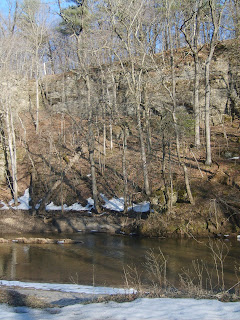I have been an avid fly fisherman for about five years now, usually at local farm ponds for your run of the mill bluegill and largemouth bass. Ever since I started fly fishing, I have dreamed of someday traveling to Northeast Iowa to try my luck at the so-called “amazing trout fishing.” In early March, a close friend and I decided to make our dreams a reality. We loaded up the necessary gear and took off to Delaware Country, located in Northeastern Iowa, for what we hoped would be a trip to remember.

Finally, we made it! The first stream we decided to try was Bailey's Ford. This stream was breath taking. We both knew that this was what we had been waiting for. After fishing this stream for about three hours with only a couple of fish following our wolly buggers, stonefly nymphs, and other assorted wet flies, we decided to pack up head to our next stream.
This is the beautiful Manchester Fish Hatchery. I was amazed by the sheer number of trout in this stream. Little did we know at the time, this was due to the recent flood that caused thousands of trout to escape the hatchery. Trout were so thick here; we thought there was no way we could get skunked here, right? Well, after about an hour or so the first fish was landed. This was no monster by any means, but it was the first trout I have ever duped into striking on a fly.

The Manchester Fish Hatchery was the most productive location we found; actually it was the only productive place that we found. On this one stream, I managed to catch about fifteen trout, consisting of a grab bag of rainbows, browns, and brooks. One minor drawback to this location is that it seemed to be fished out. Every single fish that we managed to land, were below the mandatory size limit. Some fish that were caught were centimeters away from being legal, but none the less all fish were placed back to the water.

On the final day, we decided that we were up for a journey, although we didn't really know what we were in for. We managed to locate a stream within Backbone State Park, this placed looked better on the map than it did in person. After winding through small towns and back roads, we finally located the park. This park was located in the middle of nowhere, and I mean nowhere. We got out of the car and immediately started traveling to the closest water source. After about a fifteen minute walk, we found out that this was not a stream at all! We did what any other outdoorsmen would do and went back to the vehicle to do a little more searching. FINALLY! We saw the stream, at the bottom of a giant gorge. So again, we started walking, this time for at least a half an hour. Granted, I may not be what some might call a “trout fisherman,” but this placed was awful. Not only was there not a single indication of trout being in this stream, it just took us about an hour to get here. After searching and searching for any sign of trout, we finally caught a slight glimpse of one. Immediately the flies went into the water, not wanting this trip to be a complete waste. Disappointment finally set in after the sun started to set in along the high surrounding hills. We packed up and headed back, hanging our heads in defeat.
Don't get me wrong, this was a great learning experience. I learned two main points about fly fishing for trout; number one: it’s harder than many think to catch a trout on a fly and number two: if you don't have the latest fly gear including waders, vest, rod and reel, and possibly a designer hat, you won't get the time of day from almost any other fly fisherman. After spending three days in Delaware County, only one fellow fly fisherman was kind enough to disregard the fact that we were not wearing hundreds of dollars in new fly gear. He was a pure example of what a true outdoorsman should be. Many preach about getting the youth involved in the outdoors, yet there was only one person who truly cared about getting us involved. I am going to take this experience and grow from it, simply to ensure others similar to me the, dare I say, right to outdoor experiences.